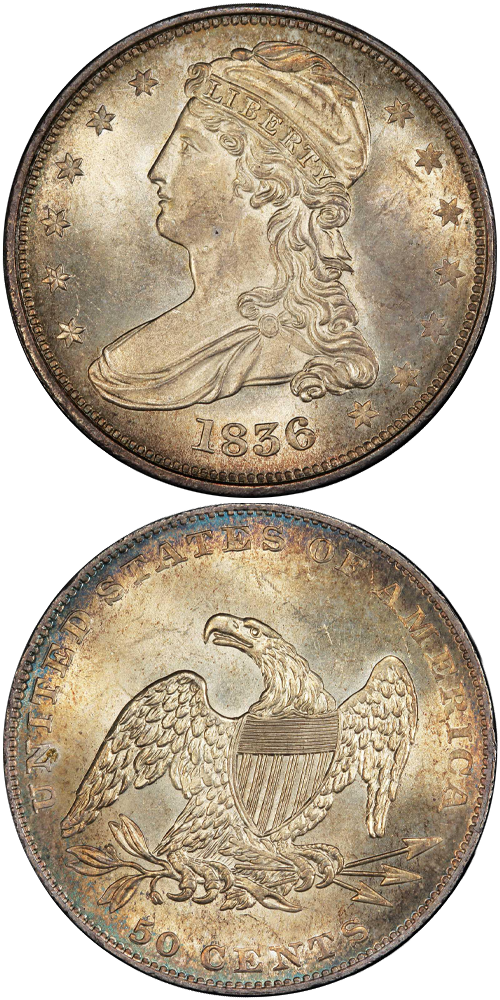1836 Capped Bust Half Dollar
The introduction of steam power to the coining process represented the single greatest technological watershed in the history of the United States Mint. Though later changes to hydraulic and electric power made coinage successively faster and increased the Mint's capacity, no other advance could match the change from mills powered by horses and presses powered by men to the neat mechanized efficiency of steam. When steam power was first connected to a press, United States coinage first became fully automated; when this coin was struck, the effort to mechanize the Mint was finally complete.
The first 1836 Reeded Edge half dollars were struck on Election Day, the second Tuesday of November 1836. Mint Director Robert M. Patterson was described in an 1854 biography by Samuel Breck as an adherent of "the Jeffersonian or Democratic school," though moderate enough that no Whig tried to displace him from office. Given his political affiliation, Patterson probably visited the polls in Philadelphia and cast a vote for Martin Van Buren, the Democratic nominee, soon to be the President-elect. In the afternoon, Patterson sat down to write a letter to another Democrat, Levi Woodbury, who served as Secretary of the Treasury in Andrew Jackson's administration and would remain in the position under President Van Buren. The letter enclosed the fruits of what must be counted as one of the most important days in the history of the United States Mint.
“I have the pleasure to send you herewith, and to beg you to exhibit to the President, the first specimens of our coinage of silver by steam, executed this afternoon. The milling as well as the striking has been done by the new machinery, and the steam-power; and the saving of labor, and the acceleration of our work, will be very great. Heretofore we have used two screw presses for coining half dollars, one of them only occasionally. The smaller of these presses required three men to work it, the larger four. The steam press, with a single hand to feed the planchets, will do more work than these two presses with seven hands. You will observe too that the work is better done. The old coin was struck in what we term an open collar; this is struck in the close collar, which makes the edge of the pieces thicker, and gives a mathematical quality to their diameters.
I think, also, you will not fail to see a considerable improvement in the impressions themselves. We do not, indeed, consider this as a new coin, such as the dollar will be; yet both the face and the reverse have been altered in many particulars, as you will see by a comparison with the old half dollar. These alterations, including a change in the diameter of the piece, are such as we introduced in the quarter-dollar, and have met the approbation of your government. I shall, in a short time, send you some impressions of the new dollar. We are busily engaged in making a press suitable for coining it.”
The ten coins Patterson sent to Woodbury, and to President Andrew Jackson by extension, could have been struck with a circulation finish or as Proofs, as reflective and beautiful as the present specimen. The estimated mintage of Proof 1836 Reeded Edge halves has generally been estimated by numismatists at either 10 or 12 pieces, but the number struck was likely somewhat larger, and for good reason. Patterson and his employees were extremely proud of their groundbreaking effort. Each half dollar struck with steam power represented the completion of a goal toward which the Mint's officers had long strived, an accomplishment august enough to mark the occasion with commemorative medals, struck on the press the previous March when the equipment was first completed. Even the press was much celebrated in later years; after making an appearance at the 1876 Centennial Exposition, it was donated to the Franklin Institute in Philadelphia and today is on display at the Museum of the American Numismatic Association.
The exact population of 1836 Reeded Edge half dollars in Proof is difficult to determine. PCGS has certified an example on 18 occasions, a number that is certainly higher than the number of discrete specimens seen. Breen claimed to know of "at least eleven different examples; a few more probably exist." Perhaps 15 to 20 exist today.
The example to the left was sold by Stack's Bowers Galleries in the D. Brent Pogue Part IV Auction, where it realized $88,125.






